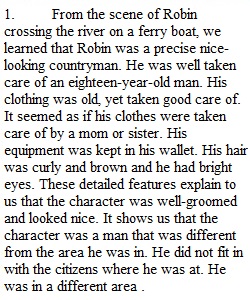


Q Nathaniel Hawthorne “Young Goodman Brown” and “My Kinsman, Major Molineux” are stories of young men on journeys that are both real and allegorical. I have found that studying the two together can be helpful in gaining a better understanding of Hawthorne. To lighten your writing load, I am only requiring that you answer written questions about “My Kinsman, Major Molineux” and then to write a short paragraph on Goodman Brown. This paragraph is a new part of the assignment. I used to assign a comparison/contrast of the two stories, but I was not seeing original thought in those paragraphs. “My Kinsman, Major Molineux” To be honest, this story is like so many of Hawthorne’s stories. We could delve deeply into symbolism and hidden meanings; however, I plan to stay more “on the surface” with this one. That does not mean that this will be a simple and easy analysis of the story, though. I have taught this several times in earlier years and decided to add it back into the mix of Hawthorne stories because I have always liked it, I think it is easy to read, and it is great for helping you understand Hawthorne. Before you read, review the themes found in Hawthorne, specifically the subconscious, loss of innocence, and ambiguity. You can find these themes in Content. Robin Molineux is on a quest – a “real” one and an allegorical one. That will be the focus of the questions. Also, note that the first paragraph of the story describes the local unpopularity of the royally appointed Colonial governors in the American Colonies during the seventeenth century. This information serves as an important “preface” to the story. As you read on, you will understand why. 1. The first scene of the story shows Robin crossing the river on a ferry boat. What details do we learn in this scene about his situation and his character? (Think of his name – What does the name “Robin” bring to mind? Notice his dress, his physical features, age, etc. READ CLOSELY.) 2. Robin’s town adventures as he searches for his kinsman teach him something about life and the world. Briefly describe the experiences he has in the three successive scenes, commenting on my questions below. a. The barber shop – Notice the laughter as he leaves the barber shop. How does he interpret this laughter? Is he really the “shrewd youth” he thinks he is? b. The tavern – Again he encounters laughter, and again, “with his usual shrewdness,” he thinks he knows why they are laughing. Comment on this. c. The house with the “pretty mistress” – What does this scene tell you about his kinsman? Does Robin understand the temptation he is facing? Again, as he rounds the corner, he seems “to hear the sound of drowsy laughter stealing along the solitary street.” Why do you think Hawthorne continues to include laughter? What is the irony here? Think of how Robin sees himself (as shrewd) vs. the reality of the situation. 3. Robin is now determined to find his kinsman. He asks the watchman, who does not answer him, and then wanders until he finds himself outside a church. He demands of a stranger an answer to his question, “Whereabouts is the dwelling of my kinsman, Major Molineux?” What is the man’s answer? Describe the man and comment on what Hawthorne might be symbolizing in such a man. This one is tough; just think about the fact that he is two-faced, and neither face represents “good.” 4. If you think of this journey allegorically, Robin is an innocent country youth who about to “come of age.” The scene of Robin waiting outside the church is turning point in this journey. First, notice the dreamlike qualities of the scene; Hawthorne uses phrases like “beautiful strangeness,” “ghostly indistinctness,” “sleep-inspiring sound,” “low, dull, dreamy sound,” “drowsy influence,” etc. a. How does his view of the church’s interior affect him? b. What happens in his imaginative re-creation of the evening in his father’s house? Notice the question he asks himself, “Am I here, or there?” As his mind keeps “vibrating between fancy and reality,” he finds himself between the innocence of his youth and the realities of life. 5. Shortly after this scene, Robin has his first friendly encounter, a man who joins him in his wait and listens to him talk about his adventures. What does Robin learn from him? Consider the gentleman’s comments on the two-faced man leading the procession. 6. As the procession appears, there is a momentary lessening of noise, and then there is a peal of laughter. What has happened? Why does Robin eventually join in this laugher? 7. Notice the kind gentleman (from question #5) and his role at the end of the story. After the procession goes by, Robin has changed. The gentleman inquires, “Well, Robin, are you dreaming?” What is the significance of this question? What do you make of Hawthorne’s description of Robin: “His cheek was somewhat pale, and his eye not quite as lively as in the earlier part of the evening”? Why does the gentleman encourage Robin to remain in the city? He calls Robin a “shrewd youth.” Is this now true? Goodman Brown Do you consider Goodman Brown to be a sympathetic or an unsympathetic character? Write a paragraph about Brown that answers the question. Use one of the two following approaches: • Write a paragraph that begins with your answer to the question and gives at least three specific reasons from the text that support your analysis of Brown as sympathetic or unsympathetic. • If you can sincerely see Goodman Brown in both lights, write a paragraph of at least three points that first acknowledges the other view but then explains your stance. Your view should be stronger, so be sure to write more about your position than you write about the opposing view.
View Related Questions